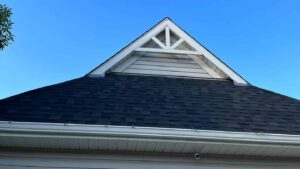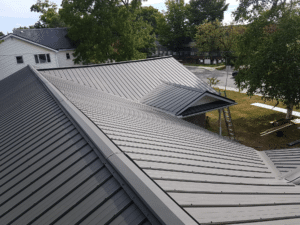
Roof ventilation may be part of your roof, but it also plays a significant role in your home’s roofing system. A good ventilation system will move air, pushing out and drawing in hot and cold air, through the attic. This helps remove moisture from the attic while it can lead to a score of moisture and water damage issues.
Proper roof ventilation is a complex system that requires the right space, design, and layout. Even if you have ventilation, if it isn’t functional, your home will still suffer from the same problems as having no system in place. When it comes to proper roof ventilation, it’s important to understand its necessity and how it all works.
Table of Contents
ToggleHow does roof ventilation work?
While parts of your ventilation may be visible from the roof, the vents themselves are installed on both the upper and lower parts of the roof beneath the eaves along your soffit. As hot air rises, it becomes trapped in the attic. As that warm air mixes with cold attic air, the air condenses and creates a moist environment. Unless dried, this invites mould growth, which can damage the roof structure or lead to serious health problems. In colder climates, that moisture can freeze and frost in the attic. With the constant freezing and thawing, that will cause something known as attic rain. This just adds to potential mould and mildew risk, along with other water damage problems.
If the insulation in the attic becomes wet, it loses its R-value, resulting in a less energy-efficient home and much higher bills. Another risk is that the trapped heat in the attic will act as a furnace against the roof, essentially baking the shingles. That causes them to age much faster, drastically shortening their lifespan.
Install proper attic ventilation to provide a means for any hot air to escape and for fresh, cold air to move in. This exchange and movement of air help keep the attic cool and dry throughout the year and your home safe. Winter is especially important for proper ventilation, as it helps prevent ice dams, which can further compromise the safety of your roof and home. Both intake and exhaust vents are necessary for the exchange and flow of air and together provide the perfect balance.
Intake vents and exhaust vents
The intake vents are located lower on the roof, typically underneath the eaves built into the soffit. This is where they can effectively draw in the cold air. Exhaust vents, though, are located higher up on the roof to help release trapped heat or moisture from the attic. These look like little towers raised above your roof. A common type of exhaust vent has a whirly-type cylinder that spins as air moves through it. Together, these vents are what allow the necessary flow of air through your roof.
There are various options for each type of vent, but the right combination and balance of vents are key. Soffit vents and ridge vents, for example, are typically paired together for very efficient ventilation. Soffit vents are a type of intake vent installed in the soffit, allowing them to draw in cold air without risking moisture buildup during the winter. Ridge vents are installed on the ridge of your roof and act as exhaust vents. These vents pair best with soffit vents as both provide low visibility, but very high efficiency. Ridge vents also release the air evenly, which helps prevent the development of cold spots in your home.
Choosing the right intake and exhaust vents
The right vent for your home will vary depending on the climate and the style of your roof and attic. Ridge vents are nearly invisible once installed, while other exhaust vents are visible on the roof’s exterior. Intake vents are often much harder to see, as they sit beneath the eaves, either in the soffit or fascia. A variety of different vent styles are available such as decorative cupola, power vents, or wind turbines. Beyond just choosing a style, another crucial part of proper attic ventilation means having an optimized design for air transfer.
An insulation contractor is typically the one who can suggest and install vents on your roof. They will do this as part of your attic insulation upgrade. They can make a recommendation for ventilation that will work best for your climate and house.
How much do you need?
An important factor in proper ventilation is ensuring that you have enough to meet the roof and house needs. A lack of ventilation affects not only the roof, but it can also compromise the R-value of attic insulation and your HVAC system. If heat is unable to escape, the AC must work harder than it needs to, trying to cool the house. Instead of working, though, it perpetuates the buildup of moisture and possible damage. Over time, parts will burn themselves out, resulting in costly replacements or repairs.
The 1/300 guideline
A good rule of thumb to follow is always to have an equal number of intake vents and exhaust vents or 1/300. The 300 refers to the amount of enclosed attic space, so for every 300 square feet, dedicate one square foot for ventilation. Measure the amount of attic floor space in your home, then divide that by 300. That number will provide the amount of ventilation space needed and then split the number in half again. It will tell you the even amount of intake and exhaust vents your home needs.
That is a great method to get an estimate of what you need, but never pass up the added expertise of a professional. They’ll handle all measurements to ensure that your roof ventilation is optimized and customized for your home. They’ll also help suggest the right style of vents and the right design to match. There’s no one size fits all, so work with a roofing contractor to find the right choice for your home. Once you do, you’ll be able to start enjoying the many benefits of roof ventilation.

1. You’ll save money
Proper attic ventilation doesn’t just save money during a set month; it provides year-round savings. Aside from the savings of keeping your roof in peak condition, it also helps with your HVAC system. Removing excess heat in the summer helps limit how often you need to run the AC, ensuring a longer lifespan. Constant airflow also means your home’s temperature will stay steady, without pockets of cold spots. During the winter, your furnace won’t have to work so hard to warm a house that constantly seems to fluctuate temperatures between rooms. Year-round your home will stay comfortable and your energy bills low, no matter what the temperature is outside.
If your roof develops moisture issues, you might have to do repairs. Replacing insulation, beams, joists, and other components of your attic will be expensive. Save money with this preventative maintenance measure, and ensure your roof ventilation is working properly.
2. Your roof will last longer
If you just got your roof redone, the last thing you want to see is that it’s failing already, years before its time. Asphalt roofs or cedar shakes, for example, can easily last between 15-20 years. Without proper ventilation, though, this can drop quite a bit as premature damage deteriorates your roof. Roof ventilation helps with a longer lifespan by preventing overheating in the summer and ice dam buildups in the winter.
If you plan to do a re-roofing, talk to your roofing contractor about your ventilation system. It may be that part of the process can include improving the ventilation to ensure your roof has a long, healthy lifespan. Even if you don’t need a new roof, still call in a professional, like a roofer or insulation contractor, to inspect your system. You can’t go wrong with an inspection, especially if it reveals more ways to improve your home further.
3. Better air quality and energy efficiency
An airtight home is excellent for energy efficiency, but not so great for air quality. Without an exchange of fresh air, you’re continually breathing recycled air. Another benefit of attic ventilation is it helps with improving indoor air quality and lowering pollutants. Poor air quality can worsen symptoms for people with asthma or allergies. If mould develops and goes unnoticed, the spores can cause severe respiratory problems. With proper ventilation, though, it helps ensure that these problems and risks don’t occur. The constant cycle of air provides clean and healthy air while removing excess heat, dust, and moisture from the house.
Combine ventilation with other measures to ensure your air quality gets twice the cleaning benefits. Avoid smoking indoors, control humidity levels, and add air filtration to help provide clean and healthy indoor air. Also, invest in an annual professional maintenance check for your HVAC and duct systems. Routine maintenance will ensure everything runs smoothly and that your air ducts and filters stay clear of dust. With efficient attic ventilation and an HVAC system, your home will be an energy-efficient powerhouse. You’ll enjoy saving on those monthly bills while your home stays clean and cool throughout the year.
Myths of roof ventilation
You lose heat in the winter: A big misconception of ventilation is that it will lower your energy efficiency during the winter by pushing out hot air. Inadequate insulation and leaks can cause heat loss, but there shouldn’t be excess heat in your attic, to begin with. If there is, it causes the snow on your roof to melt and then refreeze, causing ice dams and the resulting problems ice dams can cause. Proper attic ventilation helps this by giving that excess heat a place to escape during the winter. Your furnace should be heating the rooms you want, not working excessively to heat your attic.
You only need one type of vent: Balance is a key component, meaning there must be equal intake and exhaust vents, and not just one or the other. Just because your home has exhaust vents, doesn’t mean the ventilation is going to be efficient. Some heat may find its way out, but for the most part, that hot air will stay trapped inside. Likewise, with just intake vents, cold air can be drawn in but remains trapped in the attic. To optimize your attic ventilation both intake and exhaust vents benefit from professional installation.
You need lots of vents: More is also not better when it comes to roof ventilation and protecting your home. Too much ventilation can actually put your roof at risk either during storms or by disrupting the airflow. Conflicting airflow can occur where the air currents clash with one another in the attic, typically from having too many vents and too many different types. Instead of seamlessly flowing out, the air becomes trapped and negates the entire point of having ventilation.
Once you’ve calculated how many vents you need, stick with designs that complement one another. Soffits, ridges, and turbines, for example, work well with optimizing airflow. If you’re unsure which to choose, talk to your roofing contractor for some professional guidance.
How to spot poor ventilation
Catching poor ventilation before it develops into costly repairs, starts with preventative maintenance. Excess heat and moisture in the summer and ice dams or attic rain in the winter are signs or pre-existing problems. With careful maintenance and proper installation, though, these problems can be avoided.
Inside your home, if you notice excess condensation on the windows or lingering odours, it’s likely your ventilation isn’t working correctly. Likewise, wet insulation isn’t able to function properly and has a much lower R-value as a result. If you notice your home’s energy efficiency is lacking suddenly, check your ventilation and insulation. Like most systems in your home, roof ventilation needs to be maintained to keep it in top shape. Professional installation will ensure that your system is optimized and designed in the best way possible. Beyond that, combine both DIY maintenance and routine professional checkups for the best results.
DIY vent maintenance
For DIY care, check for any debris like dirt or leaves or anything that may block the exhaust vent. If you have soffit or fascia vents, keep the soffit and fascia clean and well maintained. Clean the vents as well, to keep them clear and efficient when drawing in and pushing out air. Keeping the gutters clean and clear will prevent water from backing up and damaging the roof or soffit and fascia.
Professional vent maintenance
In addition to DIY care, call in a roofing contractor for annual checks. A professional will ensure that no debris or potential blocks are affecting the ventilation. If a vent needs replacing, they’ll handle that for you. Part of a ventilation check should also include a routine roof inspection to help ensure that it is also in top shape. Any loose shingles, flashing, or debris blockage can affect the efficiency of your roof ventilation. A professional will also clean out your vents to ensure there is no dust or dirt buildup trapped inside. Right before and after winter is the best time to have your roof and vents inspected. That way, your roof will be ready for the brunt of winter weather, while a spring inspection will ensure its ready for the summer.
Find a RenovationFind Certified roofing company in your city!
| Alberta | British Columbia | Saskatchewan |
| Edmonton Roofing | Kelowna Roofing | Regina Roofing |
| Calgary Roofing | Vancouver Roofing | Saskatoon Roofing |
| Victoria Roofing | ||
| Manitoba | Nova Scotia | Newfoundland |
| Winnipeg Roofing | Halifax Roofing | St. John’s Roofing |
| Ontario | Quebec | New Brunswick |
| Toronto Roofing | Montreal Roofing | Fredericton Roofing |
| Barrie Roofing | Quebec City Roofing | Moncton Roofing |
| Hamilton Roofing | Saint John Roofing | |
| Kitchener Roofing | ||
| London Roofing | ||









